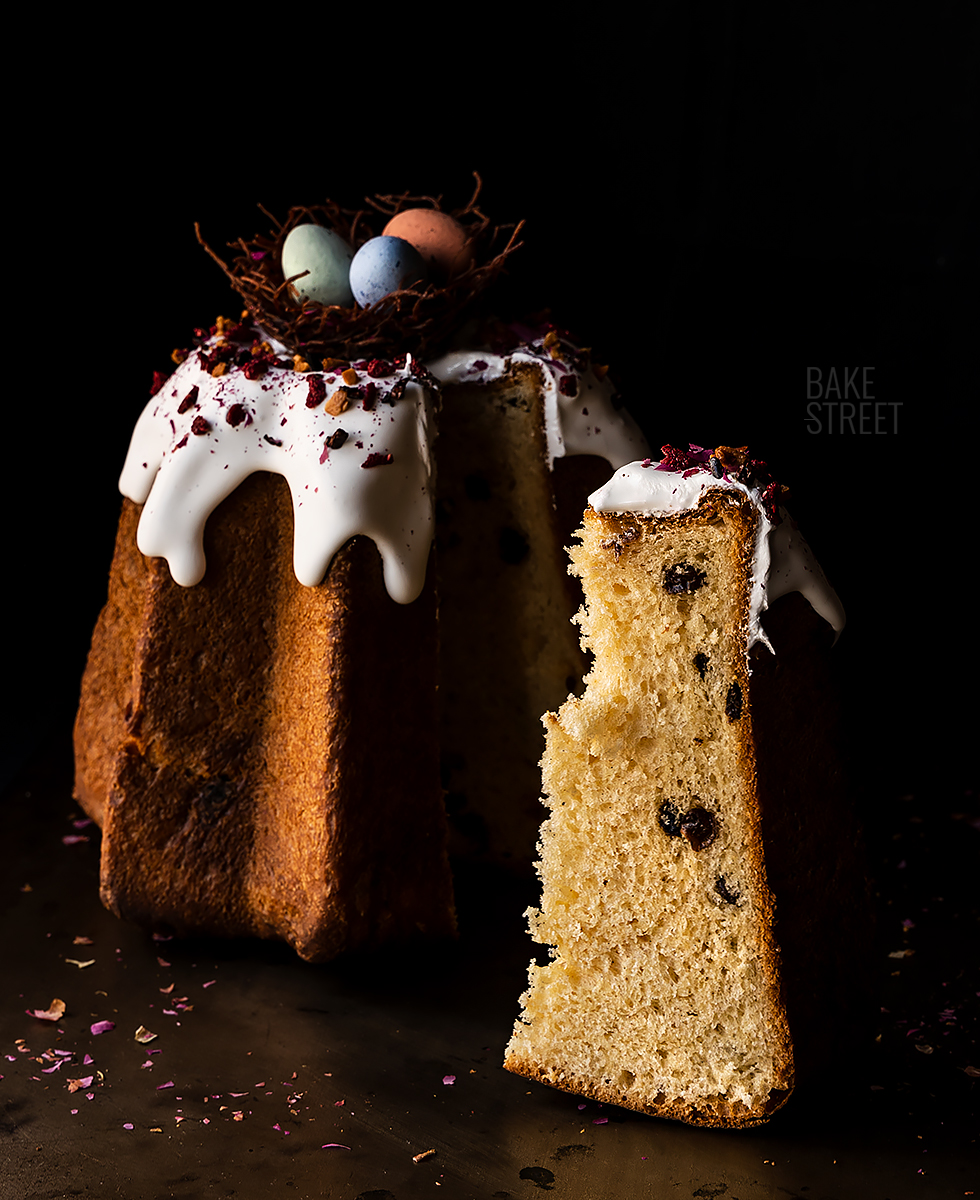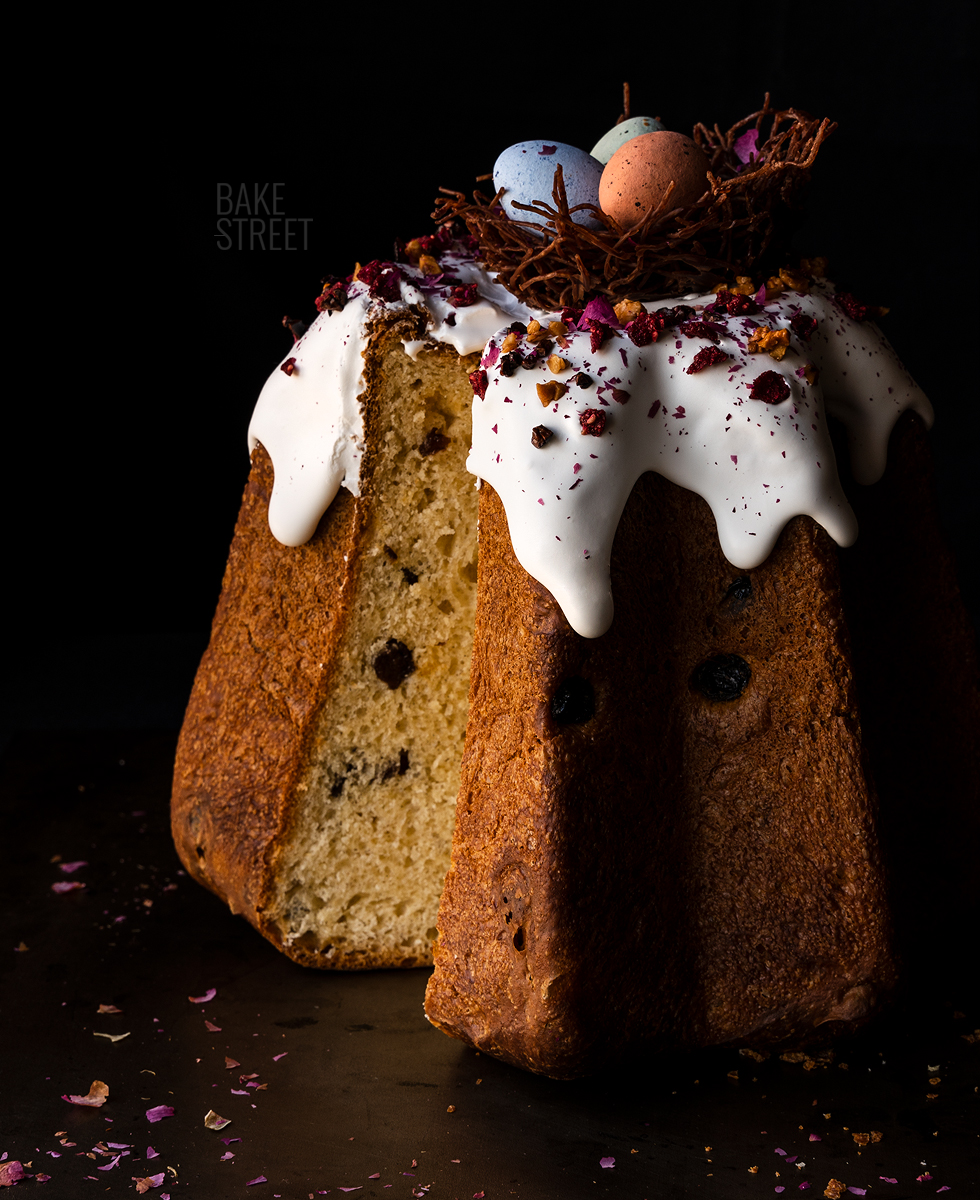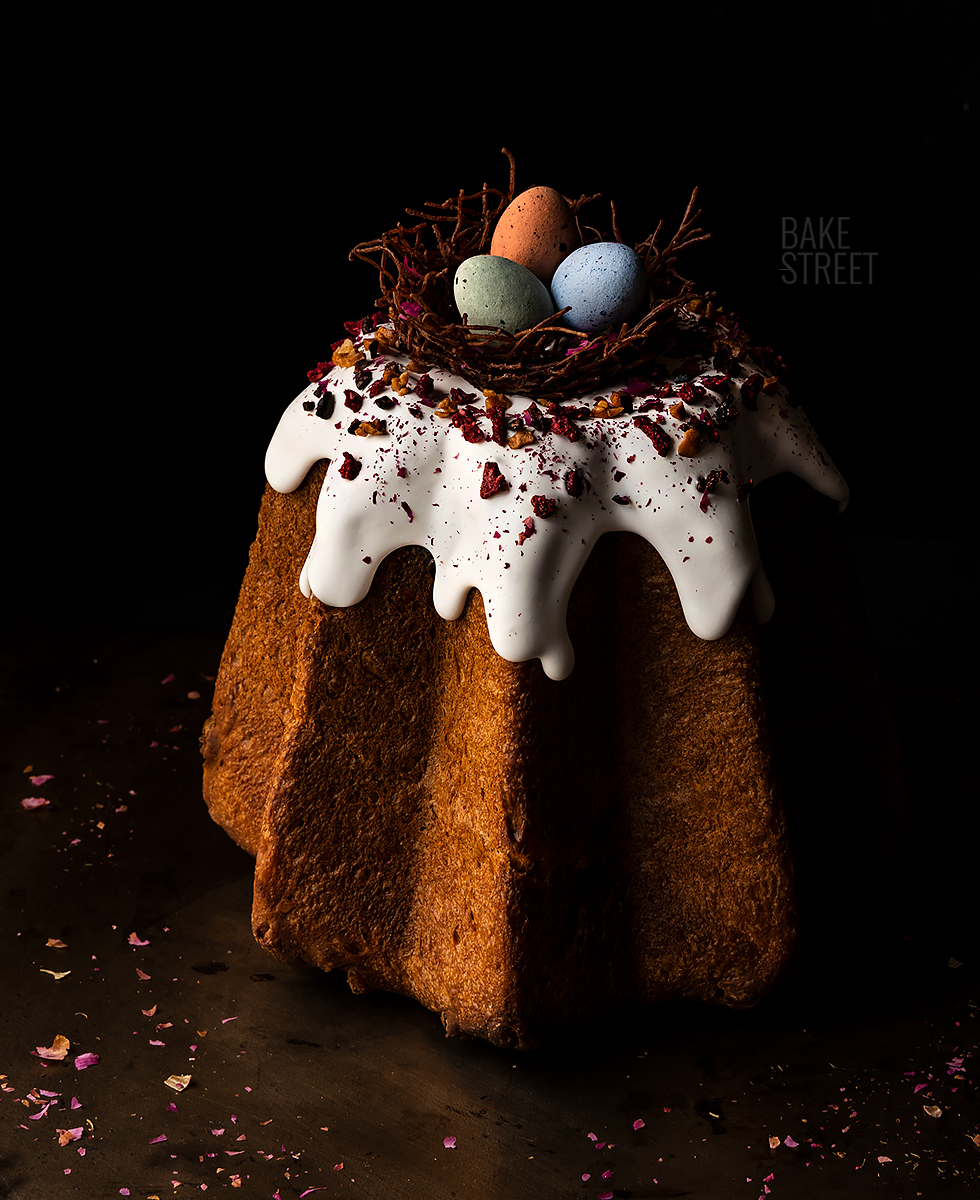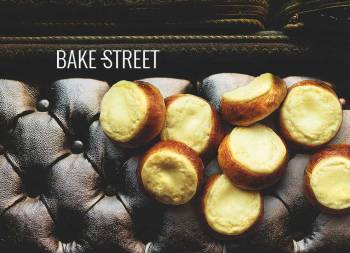
Kulich, Russian Easter bread
It’s a good time to start preparing Easter recipes, like this Kulich, Russian Easter bread. I have to say that last year I didn’t want to prepare it, but this year I wasn’t going to do it again…. I took good note of it and it has been the first recipe I have prepared for this festive season.
As a little preview, I would like to tell you that at home it has been very much appreciated, although it certainly does not have much merit… I think that any enriched dough is, without a doubt, a complete and utter success every time.
What is Kulich?
This is a traditional Orthodox Easter preparation, originating in Russia and eaten by Orthodox Christians throughout Eastern Europe in the days between Easter and Pentecost. This enriched sweet bread is made with some ingredients forbidden during Lent, making it highly appealing to those who have done without them during the 40 days leading up to Easter.
In many communities, the priest blesses the kulich made by members of the community, and it is eaten for breakfast with cheese spread known as paskhaand eggs dyed red to symbolise the blood of Christ.
The Orthodox Easter celebration is known as Pascha. It is an important holiday for Orthodox Christians, who spend the 40 days leading up to Easter observing Lent and attending regular church services. On Easter Sunday, Orthodox Christians usually attend midnight ceremonies to celebrate Christ’s resurrection, and a special Easter meal, often including kulich in Russian Orthodox communities, follows the midnight service.

This Easter bread is baked in a cylindrical mould, resulting in a bread with a cylindrical shape and a domed dome.
The top is covered with white icing that runs down the sides and is often decorated with religious symbols or the letters ‘XB’ – ‘Христос воскрес‘, which means ‘Christ is risen’ in the Cyrillic alphabet. This is the traditional Russian greeting at Easter. The response to this greeting is “Воистину воскрес”.
When kulich is served, the upper part (the dome) is usually cut off and placed in the centre of the dish, and the rest of the cylinder is cut into wedges. Nowadays, most Russians cut the kulich like a normal cake, into wedges, cutting it straight across from top to bottom. However, this traditional method was the one used in the old days. First the ‘корона‘ was cut, and then the rest of the bread was cut into horizontal slices or wedges, to be divided among the members of the family.
The “корона” was then placed back on top of the excess bread. In this way, not only did it maintain its aesthetic appearance, but it also helped to preserve the bread’s freshness.
This is made with a basic milk bread dough that includes dried fruits, such as sultanas, and nuts, such as almonds. We already know that, depending on the hands that make it, there are an infinite number of variations. Among them, some bakers add candied fruit, orange or lemon, citrus zest or spices such as vanilla, cloves and saffron (I have even seen some recipes carried out with a little green cardamom). You can also add a small amount of rum or brandy to the batter to flavour it.
Historically, wealthier cooks would load their kulich with spices, taking advantage of the relaxation of Lenten rules to make a special preparation.
Kulich origin.
The name kulich, kulitsch, in Russian Кулич, originates from the Greek word “kollix“, meaning “a loaf of bread“.
Its creation dates back to the resurrection of Christ. According to the Bible, on the day of the resurrection, the apostles prepared the table and sat down in the centre, which was formerly Christ’s place, and served freshly baked bread.
Legend has it that when Christ visited the apostles, he ate from this loaf of bread with them.
There is no mention of the kulich in the Old Testament. So its history goes back to ancient pagan times. At that time, one of the Christian customs was the preparation of Easter cakes and their consecration in church. Kulich is therefore considered a pagan pastry.
After Christ’s resurrection, kulich became a Christian tradition. Thus, although it appeared long before Christianity, it was integrated into the religious society without any problems, like many phenomena of the pagan world.
The Christian tradition has nothing to do with paganism. The pagans probably had a similar tradition, but in Christianity, kulich has a completely different meaning.

Kulich acquired its modern shape thanks to the Polish king Stanislav Leshchinsky in the early 17th century, invented by his chef.
The top of each loaf is called ‘корона‘ or ‘crown‘ and is usually covered with a sugar glaze that is drizzled down the sides of the loaf. The spikes created are vaguely reminiscent of Christ’s crown of thorns.
Kulich is traditionally eaten only at Easter. It is usually placed next to the “писанки” (Easter eggs, also called пасхальные яйца) and is served together with “пасха“, Easter cottage cheese, a rich dessert made of thick cottage cheese, nuts, butter and other ingredients. Before consumption, the three elements are traditionally placed in a single basket and taken to a priest for blessing at the service on the Saturday before Easter Sunday.
Easter morning.
At Easter breakfast, when the Lenten fast is broken, the head of the household distributes a blessed Easter egg among all members of the household, and does the same with кулич and пасха. Each portion is said to contain happiness for the coming year.
Kulich is believed to possess a number of mystical properties, and for that reason several kulich are baked for Easter celebrations. At least one of them is intended to be eaten by the family. The rest may be baked to give to the local priest as a tithe, others to feed to farm animals to ensure their health and virility, and still others may be baked and left in a traditional ‘красный угол‘, or ‘red/beautiful corner‘, which is where Russian households traditionally kept icons in honour of dead relatives.
Kulich can be made in different shapes, but traditionally it is usually round and tall.
Baking kulich was one of the most important ceremonial tasks for the woman of the house, as the fate of the family depended on it. Russians have traditionally been a dramatic and superstitious people, and this applied even to the baking of the kulich.
It was said “если кулич хорошо поднялся и вышел ладный, то в семье будет все хорошо. А если тесто в печи не подошло или растрескалась корка, надо ждать несчастья“. (If the kulich rises well and forms well, it means that the family will be fine. But if the dough does not rise in the oven, or if the crust cracks, it foretells disaster).
To decorate it, it can be covered with a sugar or white chocolate glaze. Although there are also some uncovered, just scored with a cross in the dough that was made before baking.
The preparation of the dough is a ritual that must be carried out in peace and quiet, since it is a family sacrament on which, as the ancestors believed, the life of the family depended.
It is forbidden to prepare a kulich dough in a hurry or in a bad mood. Russians believe that it is a food capable of absorbing the energy of the person who makes it and thus transmitting it. It is important for the person making it to be in an excellent state of mind so as not to transmit irritation and fatigue to his or her family during these holy days.
So I have little to say…. Make sure you take a deep breath and have all the time you need to do it, without rushing. With a lot of care, patience and love. But not only for this preparation, but for all the ones you prepare. Remember that there will always be a little bit of you in everything you do.
Recipe Kulich, Russian Easter bread
PREFERMENT:
- 100 g Manitoba flour or high-strength flour, W=380-400
- 114 g water
- 1 g fresh yeast or 0,3 g dry yeast
DOUGH:
Recipe adapted Liza Glinskaya
- 335 g Manitoba flour or high-strength flour, W=380-400
- all of the preferment
- 55 g sugar
- 28 g honey
- 12 g fresh yeast or 4 g dry yeast
- 3 eggs L + 1 egg yolk (total 200 g)
- 165 g unsalted butter, cold
- 1/2 g vanilla pod
- 7 g salt
- 12 g milk powder, optional
- 100 g sultanas + syrup (100 g water + 20 g rum/cognac + 120 g sugar)
GLAZE:
- 1 egg white, in my case 38 g, at room temperature
twice the weight of sugar as egg white, in my case 76 g
FOR DECORATING:
- caramelised freeze-dried raspberry
- caramelised roasted hazelnut
- caramelised cocoa nibs
- edible rose petals
- chocolate nest (ingredients below)
CHOCOLATE NEST:
Idea created by Cookies, Cupcakes and Cardio
- rice vermicelli
- about 20 g melted chocolate
- chocolate Easter eggs
MATERIAL WE WILL NEED:
- kneader
- Pandoro mould or panettone capsules
- bowls
- spatula
- digital kitchen thermometer
- cooling rack
Instructions
NIGHT BEFORE
Prepare preferment.
- In a bowl, mix the flour with water and yeast. Mix until the mixture is homogeneous and there are no traces of flour.
- Cover with cling film or a shower cap and leave to rise overnight, about 8-10 hours.
- The rising time will depend on the outside temperature; if it is very cold, it may take a little longer for the dough to be ready. It should look as I show you in the video.
Prepare the syrup for soaking sultanas.
- In a saucepan add the water and sugar.
- Place over medium-high heat and bring to the boil. At this point, reduce the heat to medium-low and leave for 2 minutes.
- Remove from the heat and add the liqueur together with sultanas.
- Leave to soak overnight.
NEXT DAY (first day)
Prepae the dough.
- In the bowl of the kneader add the flour together with the powdered milk (if used), all the preferment and the eggs.
- Mix until the dough is amalgamated.
- Add half of the sugar and knead again until it is completely integrated.
- Incorporate the rest of the sugar and mix again.
- Add the honey and knead until well blended.
- Incorporate fresh yeast, slightly crumbled, and knead again. Once you see that it is integrated, add the salt and continue kneading.
- Check the state of the gluten mesh, it should be quite developed. Add the vanilla and knead to ensure that it is evenly distributed.
- The gluten should be well developed, at this point we begin to add the butter. We do this in batches and wait for it to be fully integrated before adding more.
- Once all the butter has been added, rest for a few minutes and check the state of the dough. We should be able to create a thin veil when we slide it between the yolk of our hands.
- Drain the sultanas and add them to the dough. Knead just until you can see that they are evenly distributed.
Make bulk fermentation.
- Grease a bowl/tupper lightly with olive oil, round the dough and put it into the bowl.
- Cover with cling film and/or its own lid and leave to rise until it doubles in size. In my case it took 3 hours at 69,8ºF/21ºC.
Shape and make final fermentation.
- Grease a pandoro mould thoroughly with butter. Set aside.
- Sprinkle a work surface, generously, with flour. Turn out the dough and shape it.
- Bring the ends towards the centre, in the same way as you would pre-shape a dough.
- Turn the dough over and roll it out.
- Put the dough into the mould with the sealing side facing upwards (the "pretty" side will be at the base of the mould).
- Cover with film or a shower cap, leave to rise at room temperature for 1 hour (in my case to 69,8ºF/21ºC).
- Then refrigerate until the next day. In my case it was 15 hours to 39ºF/4ºC.
LAST DAY (second day)
Bake.
- Temper the dough for 1-2 hours, depending on the outside temperature.
- Preheat the oven to 340ºF/170ºC with top and bottom heat.
- Place the mould on a rack in the lowest part of the oven and bake for 50-55 minutes. Halfway through baking, cover the dough with aluminium foil.
- Before removing the kulich from the oven, check the temperature inside. It should be around 194ºF/90°C.
- Remove from the oven and leave to rest for 5 minutes in the mold, remove from the mold and leave to cool completely on a wire rack.
Prepare chocolate nests.
- In a bowl, add a few vermicelli, the amount I eyeballed it. Try to visually form two nests inside the bowl.
- Pour in the melted chocolate and mix until they are completely covered with chocolate.
- Assemble the nests in two bowls lined with film. Shape and create a hollow in the centre.
- At this point, the chocolate will probably have hardened. Once the nests are assembled, place the bowls in the microwave and leave for 5 seconds. Take them out.
- You will notice that the chocolate has melted again and therefore the vermicelli strands will stick together once the chocolate hardens again.
- Refrigerate for 1 hour.
Prepare the meringue or icing.
- In a heatproof bowl, add the egg white and the sugar (remember, double the weight of the egg white).
- Place over a saucepan with water, making sure that the water never touches the bowl containing the egg whites, and keep it in a bain-marie over medium heat.
- Whisk to help the sugar dissolve with the heat, do not whisk vigorously, just mix. Once it reaches 165ºF/74ºC, remove from the bain-marie.
- Place the bowl in the KitchenAid and whip on medium-high speed until you obtain a smooth, flowing meringue, the consistency should be fluid (as I show you in the video).
Decorate kulich.
- At this point we should work without getting distracted, the reason being that we can decorate the top of the kulich more easily while the meringue is still warm. As it starts to cool, it will become more complicated.
- In my case, I put the kulich into a bowl with the meringue.... The result was not at all attractive as we need a larger quantity of meringue for this step to give good results.
- I recommend pouring/spreading it with a pastry spatula or a spoon.
- Once it is on the surface, tap it on a work surface a couple of times to help the folds settle.
- Sprinkle with whatever you like, in my case I used freeze-dried raspberries, cocoa nibs and caramelised hazelnuts, but you can use whatever you like: nuts, sprinkles, flowers...
Assemble the nest.
- Carefully remove the nests from the bowls and decorate with small Easter eggs.
- Place the nest on top of the kulich, finish by sprinkling with powdered rose petals (we will do this with our hands).
Leave to dry for 1-2 hours, if desired (this step is not essential, but it allows the meringue to be dry to the touch and creamy inside). - Serve.

Notes
- To make this dough I have used a high-strength flour, we need to use a flour with a high percentage of proteins to allow us to enrich it and carry out the fermentations which, in this case, are long.
- The sugar is added in two batches to ensure that it is well integrated into the dough and does not liquefy it. Sugar is hygroscopic, which means that it has the ability to attract moisture from the environment.
- If we do not have vanilla pods, we can use vanilla paste or vanilla extract (1 teaspoon).
- The egg white left over from the egg yolk added to the dough will be used to make the top glaze for the decoration.
- The egg white must be cooked until it reaches 165ºF/74ºC, as the icing will be placed directly on the kulich. It must be heated to make it safe for later consumption.
- In my case I used a pandoro mould, but panettone capsules can be used instead. In fact, traditionally it is usually presented in this way or even baked in tins.
- It is important to respect the resting and rising times and to knead well in order to achieve a good final result. Both in flavour, aroma and texture.
- If you do not like sultanas, you can add any variety of candied fruit you like. These fruits or dried fruits help to preserve the freshness of the piece.
- The top decoration is completely optional, you can adapt it to your personal taste.
- It keeps in perfect condition for 3-4 days in a large zip bag or tightly wrapped in film.

You probably already have in mind what to make for Easter, such as the wonderful Torrijasthat you can't miss. But if you want to try something new, I recommend you to try this Russian Easter sweet bread, Kulich.
The result is a subtly sweet, soft, aromatic, spongy bread... With a meringue topping for softness, creaminess and sweetness. It is true that I have not carried out the more classic and traditional format, but I really liked the one that suggests Liza Glinskaya and, thanks to her, I decided to make it like this. In my case I made a meringue glaze, but you can make a traditional sugar glaze or even a white chocolate coating.
We liked it very much at home, very much. A perfect sweet bread to start the day with a good coffee. I hope you will try it and let me know what you think.
I wish you a wonderful weekend!
Lots of love,
Eva
Sources: Wise-geek, Folk Ways, 196 Flavors




